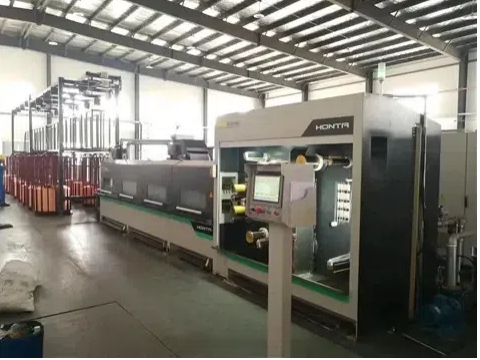Views: 0 Author: Site Editor Publish Time: 17-07-2025 Origin: Site








In today’s wire and cable manufacturing industry, rising operational costs have become a major concern for businesses worldwide. From energy bills and raw material prices to labor and maintenance, every element of production affects the bottom line. At the same time, competition demands higher quality and faster turnaround without increasing prices. In this environment, smart investment in advanced cable machinery, especially modern copper wire drawing equipment, can become a key strategy for cost control and productivity improvement. At JOC Machinery Co., Ltd., we help manufacturers strike that balance by delivering high-efficiency copper drawing systems that reduce waste, cut energy use, and increase uptime—turning your equipment into a long-term cost saver.
For many manufacturers, the decision to upgrade production equipment comes down to cost-benefit analysis: is the capital expenditure worth the operational savings?
Let’s break it down.
Initial Investment: Advanced copper wire drawing machines may require a higher upfront cost due to superior materials, automation systems, and design engineering. However, this is just one side of the equation.
Long-Term Benefits: Over time, efficient equipment consumes less power, requires fewer spare parts, reduces lubricant consumption, and experiences fewer breakdowns—all of which translate into direct cost savings.
In fact, companies that invest in intelligent cable machinery often see ROI within 12 to 24 months, especially when older machines are replaced or production volume increases.
Understanding the key cost contributors in a copper wire drawing facility is the first step to reducing them. Here are the four primary areas:
Wire drawing requires significant electrical power to drive motors, operate cooling systems, and manage tension. Outdated machines may lack energy optimization, leading to excessive electricity usage.
Continuous drawing involves high-speed metal-to-metal interaction. Lubricants reduce wear and cool the process, but they degrade over time. Frequent replacement not only increases costs but also halts production during changeovers.
Unscheduled downtime due to equipment failure can result in major losses—not just in repair costs, but also in missed delivery deadlines and idle labor. Frequent maintenance also adds to operational expense.
Older systems often require manual oversight and adjustments, increasing labor intensity. Any deviation due to human error could lead to quality issues or scrap.
Reducing costs means addressing these pain points—and that’s exactly what modern copper wire drawing equipment is designed to do.
Energy efficiency is one of the most compelling reasons to upgrade to newer copper wire drawing machines. Modern systems utilize technologies that significantly reduce electricity usage without compromising performance.
Machines equipped with VFD motors can adjust their speed in real-time according to load demand. Instead of running at full speed regardless of requirement, they intelligently match energy output to actual need, reducing waste and heat buildup.
Advanced cable machinery often features closed-loop lubrication and cooling systems. These recycle fluids through filters and cooling chambers, minimizing losses and reducing the need for constant replenishment.
When not drawing wire, modern machines can enter an energy-saving idle mode or automatically shut off non-essential components. These features, combined with real-time monitoring, help cut power bills substantially.
Based on industry case studies (e.g., gcreurodraw.com and hoohawiremachine.com), such upgrades can result in 10–30% reductions in energy consumption compared to conventional systems.

Drawing quality and cost are directly tied to the quality and longevity of dies and lubricants. Here’s how:
High-quality drawing dies—such as those made from tungsten carbide or PCD (polycrystalline diamond)—last longer, require less frequent replacement, and maintain better shape under stress. While initially more expensive, they reduce long-term wear costs.
Advanced lubrication systems filter and circulate drawing fluids, keeping them cleaner and more effective for longer periods. This not only saves money but also reduces downtime for replenishment.
Machines that allow easy access to dies and lubrication components simplify routine maintenance, meaning less downtime and lower labor costs.
By selecting the right dies and managing lubricants effectively, manufacturers can extend equipment life and avoid unexpected repair costs—key for consistent ROI.
One of the most transformative aspects of modern cable machinery is its level of automation and real-time feedback. Here's how PLC (Programmable Logic Controller) systems can turn your machine into a cost-saving asset:
Maintaining proper tension across the drawing line is essential for product quality. Too much tension can snap the wire; too little affects diameter control. PLC-driven tension systems adjust continuously based on real-time sensor data, reducing breakage and scrap.
Many machines now feature early-warning systems for heat buildup, vibration, or motor irregularities. These alerts allow maintenance teams to address issues before they result in breakdowns—keeping the line running smoothly.
Modern copper wire drawing machines log real-time performance data, helping managers track output, efficiency, and error frequency. This data is invaluable for improving workflows, training staff, and scheduling maintenance only when it’s needed.
At JOC Machinery Co., Ltd., we supply copper wire drawing equipment with industry-grade PLC integration, enabling fully automated operation and remote diagnostics—an essential feature for minimizing human error and maximizing uptime.
In an increasingly cost-sensitive market, manufacturers cannot afford to run inefficient or outdated machinery. Investing in advanced cable machinery, especially modern copper wire drawing equipment, is not just a quality upgrade—it’s a strategic financial decision.
From reduced energy usage and lower lubricant consumption to predictive maintenance and minimized downtime, the cost-saving potential of smart drawing systems is substantial. And with the backing of expert engineering and global support from JOC Machinery Co., Ltd., your investment will continue to deliver value for years to come.
Contact us today to learn more about how our copper wire drawing machines can reduce your operational costs. Let us help you calculate the potential ROI for your facility—we’re ready to support your transition to smarter, leaner manufacturing.
Our OEM Stainless Steel/Brass CNC Machining Mid-Size Pneumatic Valve Body is engineered for precise flow control in pneumatic systems used across industrial automation, energy, and manufacturing sectors. Manufactured in Jiangsu, China, this valve body is available in premium stainless steel or brass to suit different environmental and performance requirements. With ±0.05 mm tolerance, every component meets stringent quality standards for durability and operational reliability.
The CB310 Custom Slewing Drive is engineered for solar power tracking systems and other industrial applications that require smooth, precise rotational control. Designed and manufactured in Jiangsu, China, this slewing drive integrates a single-row cross roller bearing for maximum stability, and is compatible with either DC motors or hydraulic motors, depending on your project requirements. With diameters ranging from 200 mm to 4000 mm, this drive is suitable for a wide range of solar panel arrays and mechanical systems.
Add: 20/FL., 26 North Zhongshan Road, Nanjing, Jiangsu, China
Tel: 0086-25-83317070
Fax: 0086-25-83303377
E-mail: peter@jocmachinery.com


